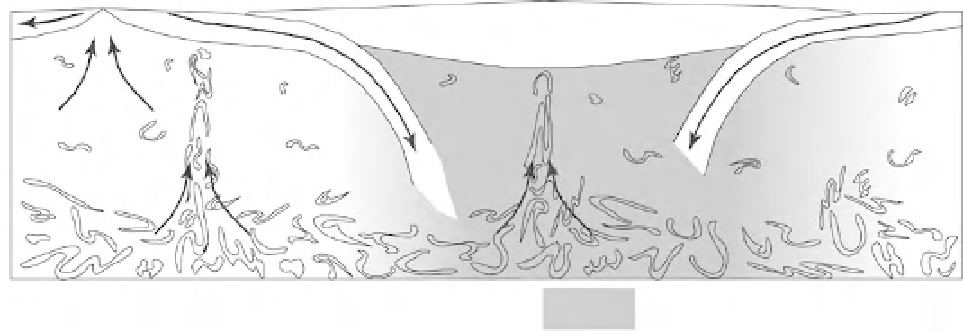Geoscience Reference
In-Depth Information
ocean
island
subduction
zone
(super) continent
subduction
zone
ridge
IC1 (
−
)
IC1 (
)
−
IC1 (
+
)
IC1 (
+
)
IC2 (
−
)
IC2 (
+
)
Fig. 13.9
Schematic illustrations for a physical model of IC1 and IC2 (i.e., two overlapping differentiation
processes, melting (for IC1) and aqueous fluid-rock interaction(IC2)). Irregular streaks represent recycling ''melt
component'' (e.g., recycling MORB and OIB), which are accumulated near the base of the convective system,
resulting in vertical IC1 variations. These streaks then ascend due to thermal instability to form plumes at ocean
islands. The horizontally distinct light (IC2-) and shadow (IC2
) regions represent those depleted and enriched in
the ''aqueous fluid component,'' respectively, possibly corresponding to the focused subduction towards the
supercontinents in the past (0.3 to 0.9 Ga).
+
the Pacific Ocean and the southern Africa to the
Indian Ocean. Iwamori
et al
. (2010) have argued
that an aqueous fluid component, including hy-
drogen, subducts to the bottom of the mantle
and could affect the seismic velocity structure at
CMB, although the high IC2 regions partially in-
clude non-LLSVP. A possible explanation for the
partial correlation between IC2 and LLSVP will
be discussed later.
These two independent fractionation processes
responsible for IC1 and IC2 variations may over-
lap with each other: both the recycling melt-rich
components and the residual portion may exist
in both the slab to be dehydrated and the man-
tle wedge to be hydrated beneath the volcanic arc
(e.g., as in Figure 13.7). Therefore both dehydrated
and hydrated melt-rich portion may be created,
and similarly, dehydrated and hydrated melt-poor
portion can be created through the subduction
zone processes. These various products will be
proceeded to the source regions of MORB and
OIB to create the observed isotopic variability as
in Figure 13.8.
Integrating all the arguments in this chapter,
we propose a model for water subduction
from the surface to the bottom of the mantle.
Focused subduction towards a supercontinent
may create a source region enriched in aqueous
fluid components that will bring high-IC2
values through radiogenic ingrowth with time.
At the shallow part in the course of water
subduction, a significant amount of H
2
Ois
released by the time it reaches the choke point
to form a magmatic-hydrothermal arc above the
subducting slab. Aqueous fluids ascent as porous
and channel flows through the solid corner flow
beneath the arc. The solid corner flow may
contain 0.1-0.4 wt % H
2
OhostedbyNAMseven
after breakdown of major hydrous phases (such as
serpentine and chlorite), and the resultant HBL
just above the slab transports it to the mantle
transition zone. If a stagnant slab is formed
due to, e.g., buoyancy at 660 km discontinuity
associated with the phase change or viscous
weaknening of the slab at 410 and/or 660 km
depth also due to the phase changes (Nakakuki
et al
., 2010), the HBL may cause Rayleigh-Taylor

